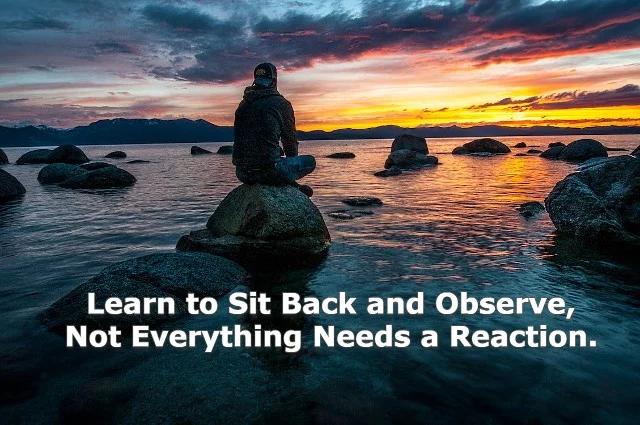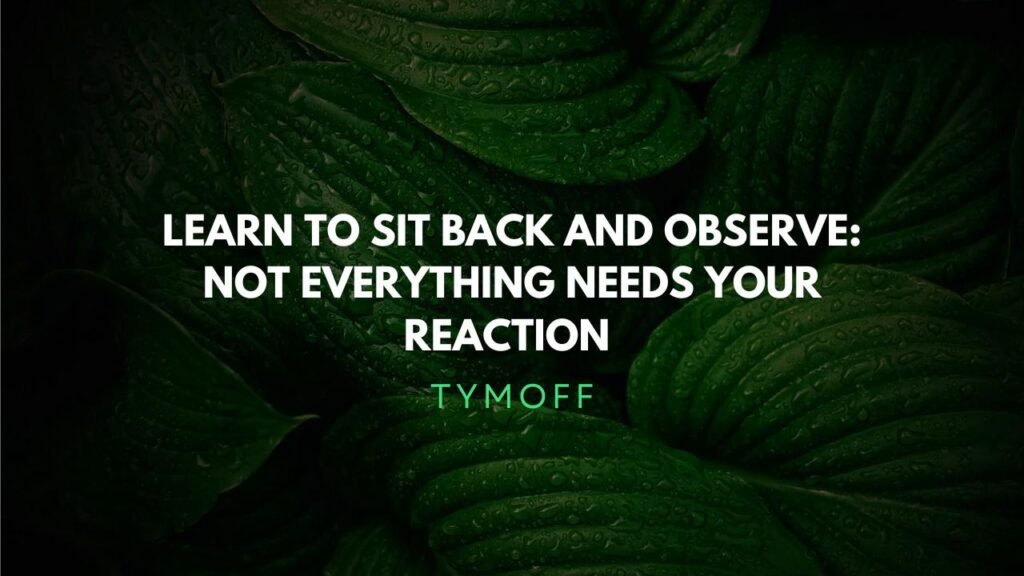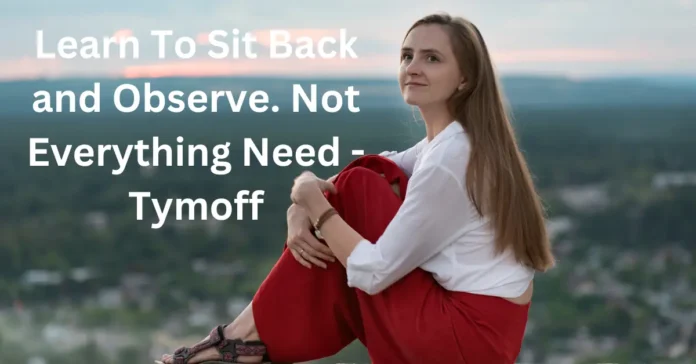“Learn to sit back and observe. Not everything needs a reaction – Tymoff” is more than just good advice; it’s a life-changing habit. Sometimes, we feel the urge to jump in and react to every little thing, but this often leads to unnecessary stress and mistakes. By learning to sit back and observe, you give yourself a chance to understand situations better before acting.
This approach helps us make smarter choices and build stronger relationships. Instead of reacting impulsively, we can pause, gather information, and respond in a way that makes things better. So, let’s explore how this simple yet powerful concept can improve our daily lives!
What Does “Learn to Sit Back and Observe. Not Everything Needs – Tymoff” Mean?
The phrase “learn to sit back and observe. Not everything needs – Tymoff” is all about taking a step back before reacting to situations. It means you don’t have to jump in and say or do something immediately. Instead, it’s better to watch and think first. This helps you understand what’s really going on.
By observing, you gather important information and avoid making hasty decisions. For example, if you see someone upset, observing their actions can give you clues about why they’re feeling that way. It’s not about being passive but about being thoughtful and deliberate.
When you take time to sit back and observe, you give yourself space to respond more wisely. Instead of reacting based on limited information, you can make decisions that are well-informed and considerate. This approach can lead to better outcomes in both personal and professional situations.
Why Learn to Sit Back and Observe? Understanding the Benefits
“Learn to sit back and observe. Not everything needs – Tymoff” offers several benefits that can improve your daily life. One major advantage is that it helps you make better decisions. By pausing and observing, you avoid reacting impulsively and making mistakes.
For instance, if you’re facing a tough decision at work, observing the situation carefully can provide valuable insights. Instead of making a snap judgment, you take time to understand all the factors involved. This thoughtful approach often leads to better results and less stress.
Another benefit of this approach is that it helps you manage stress more effectively. When you react quickly, it can create tension and anxiety. By observing first, you stay calm and handle situations more smoothly. This can improve your overall well-being and make interactions with others more positive.
How “Learn to Sit Back and Observe. Not Everything Needs – Tymoff” Can Change Your Life
“Learn to sit back and observe. Not everything needs – Tymoff” can truly transform the way you approach life. By adopting this mindset, you become more aware of your surroundings and your own reactions. This awareness helps you make better choices and handle challenges with more ease.
Imagine you’re in a heated discussion with a friend. Instead of reacting immediately, taking a moment to observe their body language and listen carefully can help you understand their perspective better. This can lead to a more constructive conversation and strengthen your relationship.
Additionally, this approach allows you to stay calm in stressful situations. For example, if you’re stuck in traffic, observing the situation calmly can prevent frustration. By not reacting impulsively, you can handle the situation more gracefully and maintain your peace of mind.
Steps to Practice “Learn to Sit Back and Observe. Not Everything Needs – Tymoff”
To practice “learn to sit back and observe. Not everything needs – Tymoff,” start with a few simple steps. First, when you feel the urge to react, take a deep breath. This pause helps you detach from your immediate emotions and gain a clearer perspective.
Next, observe the situation carefully without rushing to judgment. Pay attention to details such as people’s expressions and the overall atmosphere. This helps you gather useful information and avoid making snap decisions based on incomplete facts.
Then, ask questions if you need more information. This can provide clarity and help you understand the situation better. For example, if your boss gives you feedback, asking for more details can help you know how to improve.
Finally, reflect on what you’ve observed and consider different viewpoints. Trust your instincts to guide you in deciding the best course of action. This thoughtful approach ensures that your response is well-considered and appropriate for the situation.

The Power of Observation: Why It Matters to “Learn to Sit Back and Observe. Not Everything Needs – Tymoff”
Observation plays a key role in “learn to sit back and observe. Not everything needs – Tymoff.” It allows you to see the full picture before reacting. By observing carefully, you gain a deeper understanding of situations and the people involved.
For example, if you notice a colleague is quiet and withdrawn, observing their behavior might reveal they are having a tough time. This understanding helps you respond with empathy rather than jumping to conclusions or reacting with frustration.
Moreover, the power of observation helps you avoid misunderstandings. When you take the time to watch and listen, you gather accurate information. This reduces the chances of misinterpreting situations and ensures your responses are based on facts rather than assumptions.
Avoiding Impulsive Reactions: A Guide to “Learn to Sit Back and Observe. Not Everything Needs – Tymoff”
Avoiding impulsive reactions is a key part of “learn to sit back and observe. Not everything needs – Tymoff.” When you react too quickly, you might say or do things you later regret. By observing first, you give yourself time to think and respond more thoughtfully.
When you find yourself about to react, take a moment to pause. This break helps you avoid knee-jerk reactions and allows you to assess the situation more clearly. For example, if you receive unexpected criticism, instead of reacting defensively, observe the feedback and reflect on how to improve.
This approach also helps in reducing conflicts. By observing and understanding the situation, you can address issues calmly and constructively. This can lead to more effective problem-solving and better relationships with others.
How to Stay Calm with “Learn to Sit Back and Observe. Not Everything Needs – Tymoff”
Staying calm is essential in “learn to sit back and observe. Not everything needs – Tymoff.” When you observe before reacting, you maintain your composure and handle situations more effectively. This helps you approach challenges with a clear mind and reduces stress.
For instance, if you’re in a stressful meeting, instead of reacting to every comment, take a deep breath and observe the overall dynamics. This calm approach helps you respond more rationally and avoid escalating the situation.
Additionally, staying calm helps you communicate better. When you observe and control your reactions, you can listen more attentively and respond in a way that is both respectful and constructive. This improves your interactions and helps you achieve better outcomes.
Improving Relationships by Learning to Sit Back and Observe
“Learn to sit back and observe. Not everything needs – Tymoff” is crucial for building stronger relationships. By observing others and understanding their behavior, you can communicate more effectively and show empathy.
For example, if a friend seems upset, observing their actions and listening carefully helps you understand their feelings. Instead of jumping to conclusions, you can offer support that truly addresses their needs.
This approach also fosters trust. When you take the time to observe and understand others, they feel valued and respected. This strengthens your connections and enhances the quality of your relationships.
Making Better Decisions with “Learn to Sit Back and Observe. Not Everything Needs – Tymoff”
Making better decisions is a major benefit of “learn to sit back and observe. Not everything needs – Tymoff.” By taking the time to observe and gather information, you can make choices that are well-informed and thoughtful.
For instance, if you’re considering a new job offer, observing the company culture and team dynamics helps you make a decision that aligns with your long-term goals. Instead of reacting to the salary alone, you evaluate the entire situation.
This careful approach also helps you avoid mistakes. By observing and reflecting, you make decisions based on a complete understanding of the situation. This reduces the likelihood of regrets and ensures your choices are aligned with your values.
Why Sitting Back and Observing Is Key to Less Stress
Sitting back and observing is key to reducing stress. When you react quickly, it can increase tension and anxiety. By observing first, you maintain your calm and handle situations more effectively.
For example, if you’re stuck in a long line at the store, instead of getting frustrated, take a moment to observe and accept the situation. This helps you stay relaxed and avoid unnecessary stress.
Additionally, observing before reacting allows you to manage challenges more smoothly. By understanding the situation better, you can approach it with a clear mind and make decisions that minimize stress.
Understanding Others Better with “Learn to Sit Back and Observe. Not Everything Needs – Tymoff”
Understanding others better is a key aspect of “learn to sit back and observe. Not everything needs – Tymoff.” When you observe people’s behavior and listen to their words, you gain insights into their thoughts and feelings.
For example, if a coworker is quiet in meetings, observing their interactions can help you understand if they are shy or if there are other reasons for their behavior. This understanding allows you to communicate more effectively and build stronger relationships.
By applying this approach, you also improve your empathy. Observing others and considering their perspectives helps you connect with them on a deeper level and respond in ways that are supportive and understanding.
Practical Examples of “Learn to Sit Back and Observe. Not Everything Needs – Tymoff” in Action
“Learn to sit back and observe. Not everything needs – Tymoff” can be applied in many real-life situations. For example, during a heated discussion, observing the body language of others can help you gauge their emotions and respond more thoughtfully.
Another practical example is at work. If you receive unexpected feedback, instead of reacting immediately, observe the feedback carefully and ask questions if needed. This approach helps you understand the feedback better and take constructive action.
In everyday life, this approach can also be useful in managing stress. For instance, if you’re facing a long wait at the doctor’s office, observing the environment and accepting the situation helps you stay calm and patient.

The Art of Observation: How to Master “Learn to Sit Back and Observe. Not Everything Needs – Tymoff”
Mastering “learn to sit back and observe. Not everything needs – Tymoff” involves developing your observation skills. Start by practicing mindfulness and being present in the moment. This helps you notice details and understand situations more deeply.
One way to improve your observation skills is to take note of people’s body language and expressions. By paying attention to these cues, you gain insights into their feelings and reactions. This understanding helps you respond more appropriately.
Another aspect of mastering observation is asking open-ended questions. This allows you to gather more information and understand different perspectives. By combining careful observation with thoughtful questioning, you enhance your ability to respond wisely.
How “Learn to Sit Back and Observe. Not Everything Needs – Tymoff” Helps in Conflict Resolution
“Learn to sit back and observe. Not everything needs – Tymoff” is valuable for resolving conflicts. When you take time to observe the situation and understand different viewpoints, you can address conflicts more effectively.
For example, if you have a disagreement with a friend, observing their behavior and listening to their concerns helps you understand their perspective. This understanding allows you to find common ground and work towards a resolution.
Additionally, observing helps you stay calm during conflicts. By focusing on the situation rather than reacting emotionally, you handle conflicts more constructively and avoid escalating tensions.
Seeing the Bigger Picture with “Learn to Sit Back and Observe. Not Everything Needs – Tymoff”
Seeing the bigger picture is a key benefit of “learn to sit back and observe. Not everything needs – Tymoff.” By observing situations from a broader perspective, you gain a more comprehensive understanding of what’s happening.
For example, if you’re planning a project, observing all aspects of the project helps you see how different elements fit together. This broader view helps you make better decisions and anticipate potential challenges.
This approach also helps you avoid tunnel vision. By observing and considering various factors, you make more informed choices and address issues more effectively. Seeing the bigger picture leads to more successful outcomes and fewer surprises.
Tips for Practicing “Learn to Sit Back and Observe. Not Everything Needs – Tymoff” Daily
To practice “learn to sit back and observe. Not everything needs – Tymoff” daily, start by incorporating simple habits into your routine. Begin by taking a moment to pause before reacting in any situation. This helps you gather your thoughts and respond more thoughtfully.
Another tip is to practice active listening. Pay attention to what others are saying without interrupting or planning your response. This helps you understand their perspective better and respond more appropriately.
Additionally, reflect on your observations regularly. Take time to think about what you’ve learned and how it can inform your actions. This reflection helps you improve your observation skills and apply them more effectively in different situations.
The Impact of Observing First on Your Well-Being
Observing first has a positive impact on your well-being. When you take the time to understand situations before reacting, you reduce stress and make better decisions. This approach helps you handle challenges more calmly and thoughtfully.
For example, if you face a difficult situation at work, observing the details and reflecting on your response helps you manage your stress. By avoiding impulsive reactions, you maintain your mental and emotional balance.
This approach also contributes to better relationships. By observing and understanding others, you communicate more effectively and build stronger connections. This enhances your overall well-being and creates a more positive environment around you.
What to Do After Observing: Next Steps in “Learn to Sit Back and Observe. Not Everything Needs – Tymoff”
After observing a situation, the next steps in “learn to sit back and observe. Not everything needs – Tymoff” involve careful consideration and thoughtful action. First, reflect on what you’ve observed and consider different perspectives.
Once you’ve gathered enough information, decide on the best course of action. This decision should be based on your observations and reflection, ensuring that it addresses the situation effectively.
Finally, take action in a calm and measured way. Implement your decision thoughtfully and observe the results. This approach ensures that your response is well-considered and appropriate for the situation.
Common Mistakes to Avoid When Learning to Sit Back and Observe
When learning to “sit back and observe. Not everything needs – Tymoff,” avoid common mistakes that can undermine your efforts. One mistake is reacting too quickly, even after observing. It’s important to take time to reflect before responding.
Another mistake is not fully observing the situation. Skipping this step can lead to misunderstandings and poor decisions. Ensure that you gather all relevant information before taking action.
Lastly, avoid letting emotions cloud your observations. Even if you’re upset or frustrated, try to maintain a clear perspective. This helps you respond more effectively and makes the process of observation more valuable.

How “Learn to Sit Back and Observe. Not Everything Needs – Tymoff” Can Improve Your Professional Life
“Learn to sit back and observe. Not everything needs – Tymoff” can significantly enhance your professional life. By adopting this approach, you become more effective in handling workplace challenges and building positive relationships with colleagues.
For instance, observing team dynamics helps you understand how to work better with others. Instead of reacting to every issue, you can address problems more strategically and build stronger professional connections.
Additionally, this approach helps you make better decisions in your career. By taking the time to observe and reflect, you can evaluate opportunities more thoroughly and make choices that align with your long-term goals.
Conclusion
In summary, learning to “sit back and observe. Not everything needs – Tymoff” is a great way to handle life’s challenges more effectively. By taking a moment to watch and think before acting, you make better decisions and reduce stress. This simple practice helps you understand situations and people more clearly, leading to better outcomes in both your personal and professional life.
Remember, reacting quickly can sometimes lead to mistakes. Instead, give yourself time to observe and reflect. This approach helps you stay calm, make thoughtful choices, and build stronger relationships. So next time you’re faced with a decision or a tricky situation, try sitting back and observing first—it can make a big difference!

